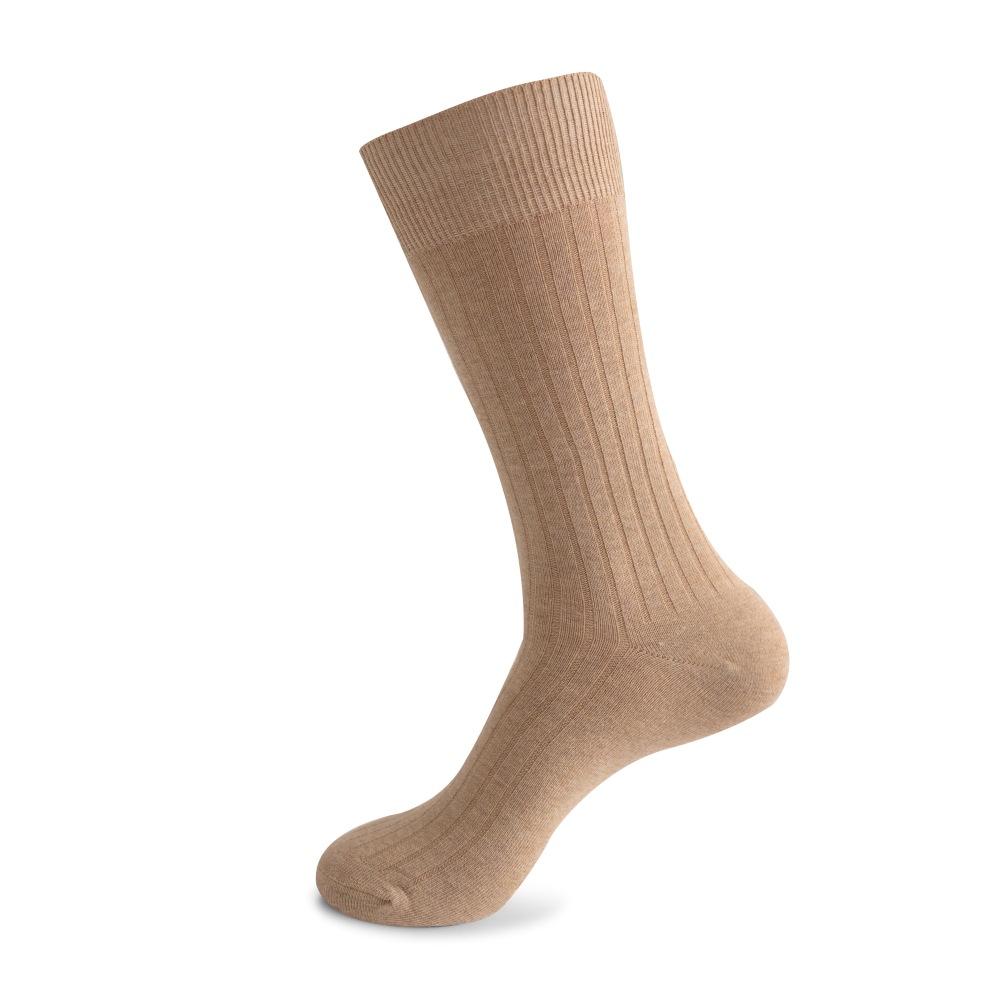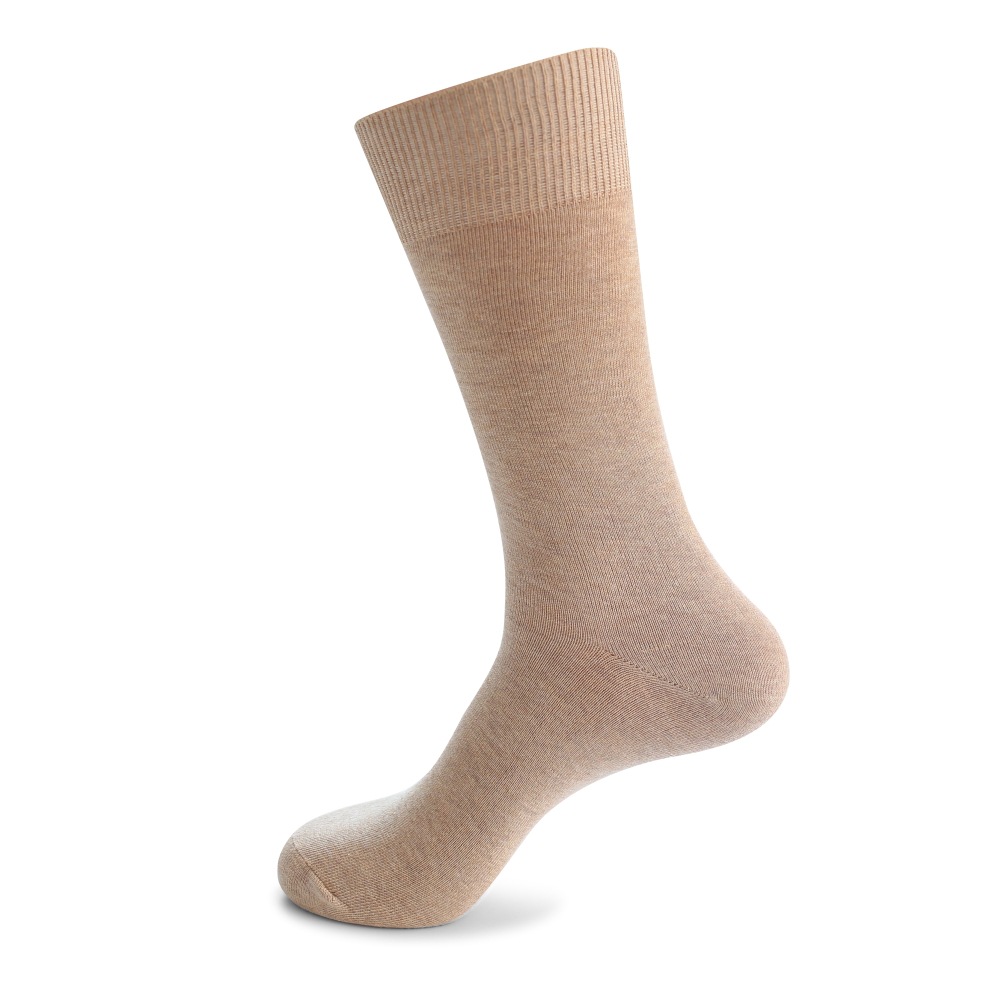Choosing the right kinds of socks for the knit technique, as well as the right weaving method for your mood and the most suitable material for comfort and performance involves many different decisions to be made. Done correctly, matching socks so that they are ‘fit for purpose’ really does become a sort of art form.
A. Different Types of sock materials
Once you have worked out what types of socks you need, the next step is to choose what they are made out of. Many factors will affect your choice of materials, from appearance to how they feel; durability or price. While there are many different types of socks material, here is a run-down of four of the most popular.
Cotton
Cotton has long been a popular choice of sock material and it does offer many advantages. Cotton is naturally derived, can hold its shape and colour well and tends not to be too expensive. Check the sewing of your cotton socks for irritating seams around the toes and heels, as these can lead to blisters or discomfort on the feet.
However, seamless cotton socks do exist and provide a soft and comfortable experience. Cotton is strong on its own but becomes even more appealing when mixed with a synthetic material, such as nylon or polyester. This adds elasticity and increases durability. Cotton socks look attractive and classy for a dressy or formal look; however, they are less suitable for working out or sporting activities as other materials are better at keeping moisture and odours at bay.
Wool
Socks have been made out of wool for much of history, and the warm, wrinkle-resistant material remains just as popular today. The natural fibres hold their shape well and are easy to wash. Wool absorbs moisture and odour and keeps its insulating properties even when wet. It also dries quicker than other materials, such as cotton.
Wool does have a few disadvantages, however, including most manufacturers’ recommendations to wash woollen socks by hand and to dry them flat to keep them looking good for longer, rather than simply bunging them into the washing machine and letting them take their chance with the rest of the laundry. Also, if you choose lower grade wool, you may find that your socks cause some itching. The smoother wools to choose tend to be higher quality varieties, such as merino or cashmere.
Bamboo
Bamboo is a relatively new arrival on the socks scene. It offers undeniable advantages in the guise of softness, sustainability and the ability to keep feet fresh and cool. Bamboo has natural anti-microbial properties, meaning that it is a highly-effective hypoallergenic choice for people with skin issues, diabetes or other medical conditions.
Bamboo is an ecologically sound choice too, thanks to the sustainable methods by which it is grown and sourced. Finally, bamboo is soft and cosy, yet light and breathable. Perfect to take on holiday and it can fold up really small in the suitcase and is easily washed and will help your feet stay fresh for hours of walking and sightseeing.
Synthetics (nylon, polyester…)
Nylon, polyester and other synthetics are an extremely viable choice for socks, thanks to their abilities to keep moisture away, dry quickly and keep your feet cool in the summer months. They tend to hold their shape well, too. Nylon and polyester are easily available and used for socks and stockings of all lengths and styles. It is strong, stable and soft, retains dyes and dries quickly. Synthetics can often be added to natural fibres, such as wool, cotton or bamboo to make the fabric more stretchy, stronger and better able to hold its shape.
Here’s a chart that will help you choose the right sock fabric as per needs and occasion.
| Need | Best Sock Fabric | Worst Sock fabric |
| Durability | Cotton, Spandex, Nylon, Bamboo, Polyester, Polypropylene | Cashmere |
| Comfort and Cushioning | Wool, Cashmere, cotton, Merino, Bamboo | – |
| Compression | Polypropylene, Spandex, Polyester | Wool, Cashmere |
| Sweat and wick moisture | Polypropylene, Polyester, Cotton |
Wool, Polyester, Cashmere, (other), Nylon |
| Lightweight | Nylon, Cotton, Bamboo | Wool |
| Warmth | Cotton, Wool, Cashmere, Merino | – |
Types of fabric for making socks as per the occasion
| Occasion | Best Fabric | Worst Fabric |
| Work | Bamboo, Polyester, Cotton | – |
| Lounging | Cotton, Cashmere, Wool | Nylon, Spandex |
| Formal | Cotton, Nylon, Spandex, Bamboo, | – |
| Winter | Wool, Cashmere, Cotton | Polypropylene, Bamboo |
| Summer | Polyester, Bamboo | Cashmere, Wool |
| Sports and athletic | Bamboo, Cotton, Nylon, Spandex, Polyester | Cashmere, Wool |
| Hiking and outdoor | Merino, Bamboo, Wool, Polypropylene | Cashmere, Polyester |
B. What are the different sock lengths?
Finally, a massive part of sock style is getting the length right. Too long, and you run the risk of your socks overpowering your outfit, or simply looking ungainly and wrong. Too short and you may not have given your feet adequate protection for the outfit you are wearing, or the activity you are doing. You can also make an outfit look unfinished or unbalanced with too short a pair of socks or the wrong types of socks.
Ankle socks
Ankle socks suit lower cut shoes, such as loafers, trainers and gym shoes. Along with slip-on socks, they are designed to protect the feet without showing above the shoe to give the impression that you are not actually wearing any socks at all. They look understated, yet add a nice finishing touch to a casual look. Team them with good quality gym, athletic or running gear or casual jeans and t-shirt outfit.
Crew length socks
Crew length socks come a little further up your foot, reaching about six to eight inches up your leg to your calf muscles. This is a highly popular length, especially for kids socks, as it helps protect young feet and ankles from insect bites, blisters and splashes from puddles etc. Crew length socks and the very similar quarter-length socks suit physical activities as they are informal, yet sturdy. They are also a great way to keep your feet and ankles warm during the winter months.
Calf-length socks
Calf-length socks tend to be more popular with men, especially those who enjoy sports and fitness activities. They offer added protection and warmth, stopping further up the leg and just below the knee. You can get calf-length socks in a wide variety of materials, including those specially designed to wick away moisture and help keep your feet fresh and ready for a good work out.
Knee-high socks
Knee-high socks are the final word in fashionable footwear, as their extended length offers a great canvass for fun designs and quirky patterns. They are a fantastic way to show off your individuality and add a vibrant colour accent to your outfit. Shine at a party and impress the world with your sense of style by investing in a bold selection of knee-high socks. Another ideal use for these types of socks is to provide an extra lining inside longer boots in the winter for added comfort when out in the cold.
Over-the-knee socks
Socks that pass the knee and stretch up to the thigh offer welcome versatility and protection for women who enjoy wearing skirts and dresses, whatever the weather, but don’t always want to reach for stockings or tights. Again, bold prints add real individuality, while smooth, flattering colours add the perfect finish touch to any outfit or style.
C. What Is The Difference Between The Single Needle Machine And The Double Needle Machine Of The Sock Knitting Machine?
Single-needle socks are referred to as Luokou for short. Luokou has a relatively prominent hair suture, while the front and back sides of double-needle Luokou are the same. The seam is relatively flat and not prominent, and it is more comfortable to wear. There is only one single needle. The needle cylinder, double needle has two needle cylinders, the machine looks like a needle cylinder is reversed on the single needle needle cylinder.
The difference between the products produced by the two machines is that the single barrel cuff is double-layered and used for weaving plain weave and loop. The cuff of the double-cylinder socks is a single layer, and the double-cylinder is used to weave the pattern with a concave and convex feeling.
The sock machine is divided into single needle cylinder and double needle cylinder, and socks are of course divided into single needle and double needle。
Recognition method: turn the sock over and look at the sock tube. If it is the same as the front of the sock, it is a double needle. If it is different, there is a tie line, which is a single needle socks.
The number of needles in the sock machine is the number of needles in the socks.
21 and 32 refer to the thickness of cotton yarn or other plant fibers. The larger the number, the thinner the thread. If it is chemical fiber, it is represented by D. The larger the number, the thicker the thread. Two-way three-color and three-way three-color are also fully computerized, which can be used for up and down needles. Multi-color jacquard and simple horizontal strips are fully computerized with up and down needles. They can be used for horizontal strips. Needle machine and single-needle machine have two-way feeding structure
Double-needle jacquard has no thread ends, single-needle jacquard has thread ends; in terms of weaving effect and overall wearing comfort of socks, double-needle socks are one grade more comfortable than single-needle socks. Many European and American socks have higher quality requirements and are designated to Made with double needles!
D. Difference between Plain Knit Fabric and Rib Fabric
This goes not only for the socks fabric, but for all fabric difference.
| Plain Fabric & Machine | Rib Fabric & M/C |
| 1. Face side and Back side of fabric are different | 1. Face side and Backside of fabric are same. |
| 2. Less expensive | 2. Expensive |
| 3. Lighter fabric | 3. Heavier fabric. |
| 4. Produce by S/J m/c. | 4. Produce by Double Jersey m/c. |
| 5. The m/c. contains no Dial. | 5. The m/c. contains Dial. |
| 6. The m/c. contains Sinker | 6. The m/c. contains no Sinker |
| 7. The m/c. contains one set of needles | 7. The m/c. contains two set of needles |
| 8. Extensibility:
a) Length wise – 10 to 20% |
8. Extensibility:
c) Length wise – 50 to 80% (for 1´1 rib) |
| 9. Thickness & Warmth: Thicker and wormier than plain woven made from same yarn. | 9. Thickness & Warmth: Much thicker and wormier than plain woven made from same yarn. |
| 10. Curling: Tendency to curl | 10. Curling: No tendency to curl |
| 11. End use: Ladies stocking, fine cardigan, men and ladies’ dresses, sweater etc. | 11. End use: Socks, cuffs, warm outerwear, under wear etc. |
Plain Knit Fabric:
The simplest and most basic structure is the ”plain knit” which is also called ”single knit”. Plain is a knit structure family, which is produced by the needles of only one set off needle with all the loops intermeshed in the same direction. Plain knitting is still a very popular technique with many knitted fabrics. Although the plain knit family encompasses a great number of structures all produced on a single needle bed.
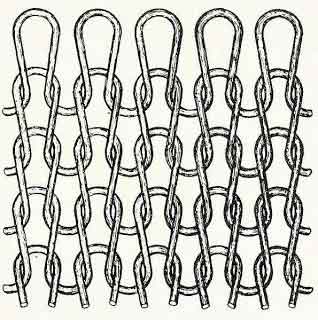 Plain knit fabric structure
Plain knit fabric structure
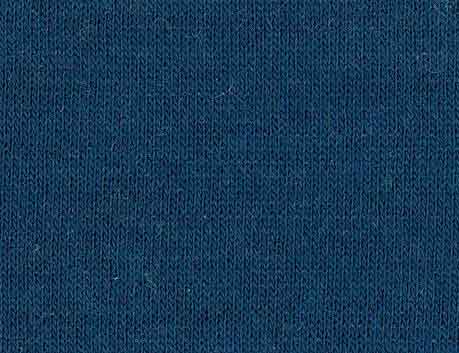 Plain knit fabric
Plain knit fabric
Rib Fabric:
Rib, also called ‘Double-knit’ is the second family of knit structures. Rib requires two sets of needles operating in between each other so that wales of face stitches and wales of back stitches are knitted on each side of the fabric. Rib fabrics are knitted on machines with two sets of needles. Rib knits have a very high degree of elasticity in the crosswise direction.
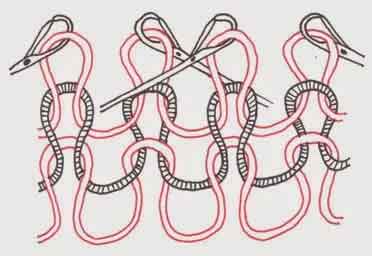 Rib Structure
Rib Structure
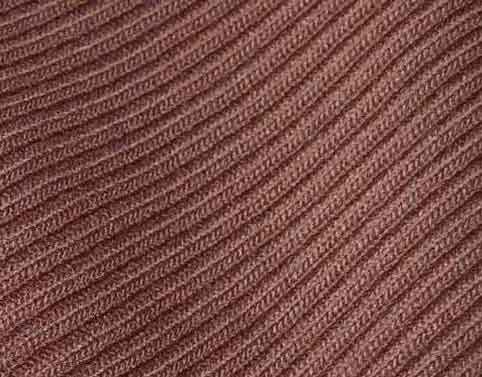 Rib Fabric
Rib Fabric
The first below is rib, and second is plain.
